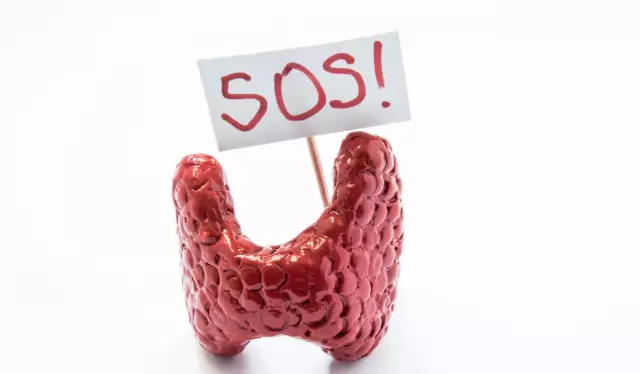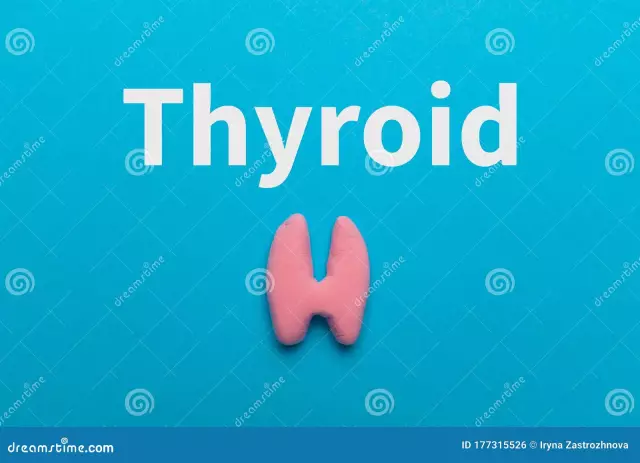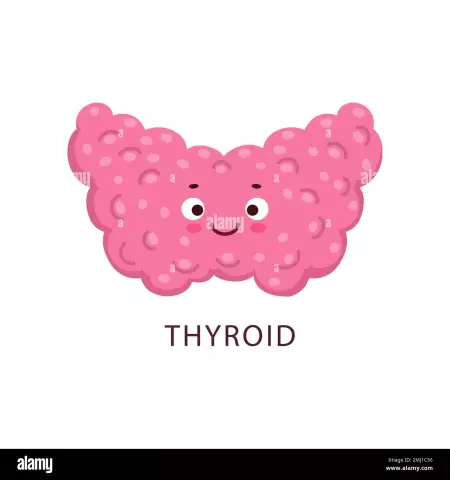- Author Rachel Wainwright [email protected].
- Public 2023-12-15 07:39.
- Last modified 2025-11-02 20:14.
Diffuse changes in the thyroid gland

The thyroid gland is an organ of the endocrine system. The gland is located on the front of the neck. It consists of two lobes and an isthmus located in front of the trachea. Often (in 30% of cases) there is a pyramidal lobe extending upward from one of the lateral lobes (usually the left) or isthmus. The mass of the thyroid gland is normally 15-30 g. The structure of a normal thyroid gland is always homogeneous. All gland tissue is represented by lobules 0.5-1 mm in diameter. The morphological unit of the thyroid gland is the follicle (vesicle). The follicle walls are composed of thyrocytes, and the lumen is filled with colloid. The main function of thyrocytes is the synthesis and secretion of thyroid hormones into the blood. These hormones include thyroxine and triiodothyronine. Thyroid hormones affect the development and functioning of the central nervous system, they increase the breakdown of protein, fat and glycogen,and also have some other effects in the body. Also in the thyroid gland there are C-cells that secrete calciotonin. This hormone influences calcium metabolism by stimulating its transfer to bone. Thus, the functions of thyroid hormones are diverse, and the importance of this gland for the body cannot be overestimated.
Focal and diffuse changes in the thyroid gland
Unfortunately, there are a number of diseases of this endocrine organ. Some of these diseases increase the function of the thyroid gland, causing excessive synthesis of hormones, others reduce the production of hormones, and still others do not affect the hormonal activity of the gland. Morphologically, diseases can be in the form of diffuse changes in the thyroid gland or in the form of focal lesions. Focal changes are a node surrounded by unchanged gland tissue. Pathology of only part of the gland can be in nodular, mixed goiter, adenoma and thyroid cancer. Such changes in the thyroid gland are not an independent disease. The cause of diffuse changes in the thyroid gland is most often endemic goiter, chronic autoimmune thyroiditis, subacute thyroiditis, diffuse toxic goiter, mixed goiter. At the heart of diffuse tissue changes is an insufficient intake of iodine into the body or an inflammatory reaction. Iodine deficiency is most often observed in endemic regions where soil and water are not rich in this trace element. Many areas in the Russian Federation are endemic. Inflammation in the tissue of the gland is most often of an autoimmune nature, that is, destruction occurs due to the pathological aggression of a person's own immunity.that is, destruction occurs due to the pathological aggression of a person's own immunity.that is, destruction occurs due to the pathological aggression of a person's own immunity.
Diagnosis of diffuse changes in gland tissue
In order to identify diffuse changes in the thyroid gland or its local lesion, palpation (feeling with the hands) of the organ is performed. Since the gland is located superficially, palpation can provide a lot of valuable information about the state of the organ. This examination is performed with the patient facing the doctor. The patient is sitting, standing or lying down. Palpation reveals nodes or diffuse changes in the thyroid gland. The size of the gland, its density, and uniformity of the structure are estimated. Signs of diffuse changes in the thyroid gland are the density and heterogeneity of the surface of the organ without pronounced focal changes, indistinct contours, and often an increased volume of the gland.
Ultrasound signs of diffuse changes in the thyroid gland
More information about the structure of the thyroid gland is given by imaging methods of examination. The most common method for imaging thyroid tissue is ultrasound (ultrasound, echography). This research is widely available and safe. It is from the conclusion of ultrasound diagnostics that the patient first learns about the presence of diffuse changes in the thyroid gland. The indication for this study is suspicion of thyroid pathology. The reason may be hormonal disorders, complaints or examination results. In the absence of data in favor of thyroid pathology, ultrasound is not performed, since it is not a screening study. Unfortunately, nowadays many patients independently decide to undergo an ultrasound of the thyroid gland. The obtained data on the heterogeneity of the structure,follicular changes or diffuse heterogeneity cause anxiety for the patient and unnecessary interventions.

During an ultrasound examination of the lobes of the thyroid gland, their size is determined, then the volume of the thyroid gland is calculated using a special formula. Then the echo structure and echogenicity of the thyroid gland are assessed. The echo structure can be homogeneous and heterogeneous. A homogeneous structure is characterized by a uniform distribution of echo signals of the same size and location. An inhomogeneous echo structure is an unevenly spaced alternating echo signals of various intensities and sizes. The echogenicity of the gland is compared with the echogenicity of the surrounding tissues. It can be medium (normal), increased and decreased. An increase in echogenicity can be with an increase in the proportion of connective tissue in the thyroid gland. Areas of increased calcium deposition also have increased echogenicity. Increased echogenicity can be with an increase in the fluid content in the gland, excess blood filling, an increase in the proportion of thyrocytes. Local changes are described separately. Thus, according to the results of ultrasound, the doctor makes a conclusion about the presence of diffuse changes in the gland, if a heterogeneous echo structure of the tissue, increased or decreased echogenicity is found. Other imaging techniques are magnetic resonance imaging and computed tomography. They are used much less frequently due to their lower availability and potential danger to the patient. Tomography data can serve as a basis for the diagnosis of diffuse or focal lesions of the gland tissue, since these methods assess the structure and density of the organ.according to the results of ultrasound, the doctor makes a conclusion about the presence of diffuse changes in the gland, if a heterogeneous echo structure of the tissue, increased or decreased echogenicity is found. Other imaging techniques are magnetic resonance imaging and computed tomography. They are used much less frequently due to their lower availability and potential danger to the patient. Tomography data can serve as a basis for the diagnosis of diffuse or focal lesions of the gland tissue, since these methods assess the structure and density of the organ.according to the results of ultrasound, the doctor makes a conclusion about the presence of diffuse changes in the gland, if a heterogeneous echo structure of the tissue, increased or decreased echogenicity is found. Other imaging techniques are magnetic resonance imaging and computed tomography. They are used much less frequently due to their lower availability and potential danger to the patient. Tomography data can serve as a basis for the diagnosis of diffuse or focal lesions of the gland tissue, since these methods assess the structure and density of the organ. Tomography data can serve as a basis for the diagnosis of diffuse or focal lesions of the gland tissue, since these methods assess the structure and density of the organ. Tomography data can serve as a basis for the diagnosis of diffuse or focal lesions of the gland tissue, since these methods assess the structure and density of the organ.
Treatment of diffuse changes in the thyroid gland
The reasons for diffuse changes in the thyroid gland are different, respectively, and therapy can be different. Treatment of diffuse changes in the thyroid gland with endemic goiter is carried out using iodine preparations. If there is no effect, the hormonal preparation L-thyroxine is added to the treatment. In chronic autoimmune thyroiditis, conservative treatment is prescribed only if hypothyroidism is present. Also, the treatment of diffuse toxic goiter aims to suppress the excessive synthesis of hormones by the thyroid gland. Treatment of diffuse changes in the thyroid gland in these diseases is not carried out. In case of significant enlargement of the gland and compression of the surrounding tissues, an operation is used.
YouTube video related to the article:
The information is generalized and provided for informational purposes only. At the first sign of illness, see your doctor. Self-medication is hazardous to health!






